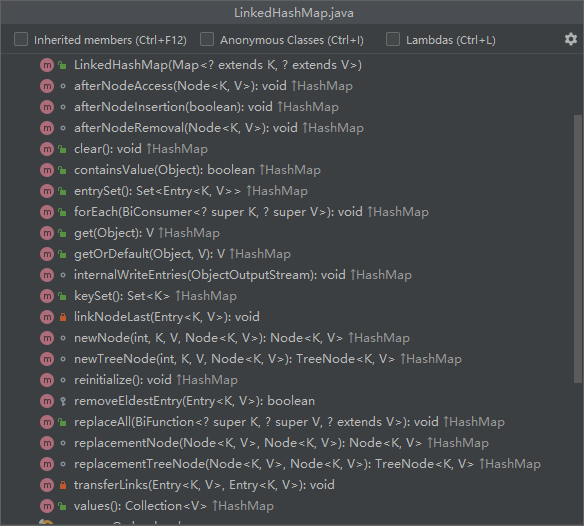一个键有序的 HashMap
可以将 LinkedHashMap 理解为 LinkList + HashMap,所以研究LinkedHashMap之前要先看HashMap代码。这里不再赘述。其实LinkedHashMap无非就是通过链表结构将存储在HashMap中的数据通过 beofre,after连接起来。
方法

作为一个链表结构 head,tail必不可少
/**
* The head (eldest) of the doubly linked list.
*/
transient LinkedHashMap.Entry<K,V> head;
/**
* The tail (youngest) of the doubly linked list.
*/
transient LinkedHashMap.Entry<K,V> tail;
还要有一个存储 前节点和后节点的数据结构
/**
* HashMap.Node subclass for normal LinkedHashMap entries.
*/
static class Entry<K,V> extends HashMap.Node<K,V> {
Entry<K,V> before, after;
Entry(int hash, K key, V value, Node<K,V> next) {
super(hash, key, value, next);
}
}
最后,为了支持节点根据访问频率更新节点顺序,增加了 accessOrder 变量
/**
* The iteration ordering method for this linked hash map: <tt>true</tt>
* for access-order, <tt>false</tt> for insertion-order.
*
* @serial
*/
final boolean accessOrder;
put 方法
LinkedHashMap中的put方法没有重写,其实就是HashMap中的put方法。不过它给子类留了可供重写的方法。 afterNodeAccess(e) 和 afterNodeInsertion(evict);
final V putVal(int hash, K key, V value, boolean onlyIfAbsent,
boolean evict) {
Node<K,V>[] tab; Node<K,V> p; int n, i;
if ((tab = table) == null || (n = tab.length) == 0)
n = (tab = resize()).length;
if ((p = tab[i = (n - 1) & hash]) == null)
tab[i] = newNode(hash, key, value, null);
else {
Node<K,V> e; K k;
if (p.hash == hash &&
((k = p.key) == key || (key != null && key.equals(k))))
e = p;
else if (p instanceof TreeNode)
e = ((TreeNode<K,V>)p).putTreeVal(this, tab, hash, key, value);
else {
for (int binCount = 0; ; ++binCount) {
if ((e = p.next) == null) {
p.next = newNode(hash, key, value, null);
if (binCount >= TREEIFY_THRESHOLD - 1) // -1 for 1st
treeifyBin(tab, hash);
break;
}
if (e.hash == hash &&
((k = e.key) == key || (key != null && key.equals(k))))
break;
p = e;
}
}
if (e != null) { // existing mapping for key
V oldValue = e.value;
if (!onlyIfAbsent || oldValue == null)
e.value = value;
//
afterNodeAccess(e);
return oldValue;
}
}
++modCount;
if (++size > threshold)
resize();
//
afterNodeInsertion(evict);
return null;
}
afterNodeInsertion 当有新节点插入时,是否删除第一个节点。 removeEldestEntry在此类中返回了 false,所以,不会删除任何一个节点。
// possibly remove eldest
void afterNodeInsertion(boolean evict) {
LinkedHashMap.Entry<K,V> first;
if (evict && (first = head) != null && removeEldestEntry(first)) {
K key = first.key;
removeNode(hash(key), key, null, false, true);
}
}
另外,LinkedHashMap 重写了 newNode方法。以将新节点插入到链表最后一个节点上
tab[i] = newNode(hash, key, value, null);
Node<K,V> newNode(int hash, K key, V value, Node<K,V> e) {
LinkedHashMap.Entry<K,V> p =
new LinkedHashMap.Entry<K,V>(hash, key, value, e);
linkNodeLast(p);
return p;
}
private void linkNodeLast(LinkedHashMap.Entry<K,V> p) {
LinkedHashMap.Entry<K,V> last = tail;
tail = p;
if (last == null)
head = p;
else {
p.before = last;
last.after = p;
}
}
afterNodeAccess 当节点更新时,或者调用 get,getOrDefault 方法时,会根据 accessOrder 为true或者false执行该方法。
void afterNodeAccess(Node<K,V> e) {
LinkedHashMap.Entry<K,V> last;
//需要改变顺序 并且 当前节点不是最后一个
if (accessOrder && (last = tail) != e) {
// b 当前节点之前的节点
// a 当前节点之后的节点
LinkedHashMap.Entry<K,V> p =
(LinkedHashMap.Entry<K,V>)e, b = p.before, a = p.after;
//需要将p节点置为最后一个节点,所以置 p节点的 after 为 null
p.after = null;
B->P->A ===> B->P->E
//如果没有前一个节点,所以 后一个节点置为 头节点
if (b == null)
head = a;
else
//否则 将 b.after 置为 a
b.after = a;
// B->P->A ===> B->A
if (a != null)
a.before = b;
else
// B->P->NULL ===> B->A
last = b;
//如果 last 为 null,将 p 置为头结点
if (last == null)
head = p;
else {
//B -> P -> NULL
p.before = last;
last.after = p;
}
//最后将tail置为 p 节点
tail = p;
++modCount;
}
}
总结
简单看了一下代码结构,虽然细节很多都没看,但是大体上的实现就是多了一层封装,通过链表结构实现顺序存储并且还能达到 O(1)的插入和删除,查找操作。